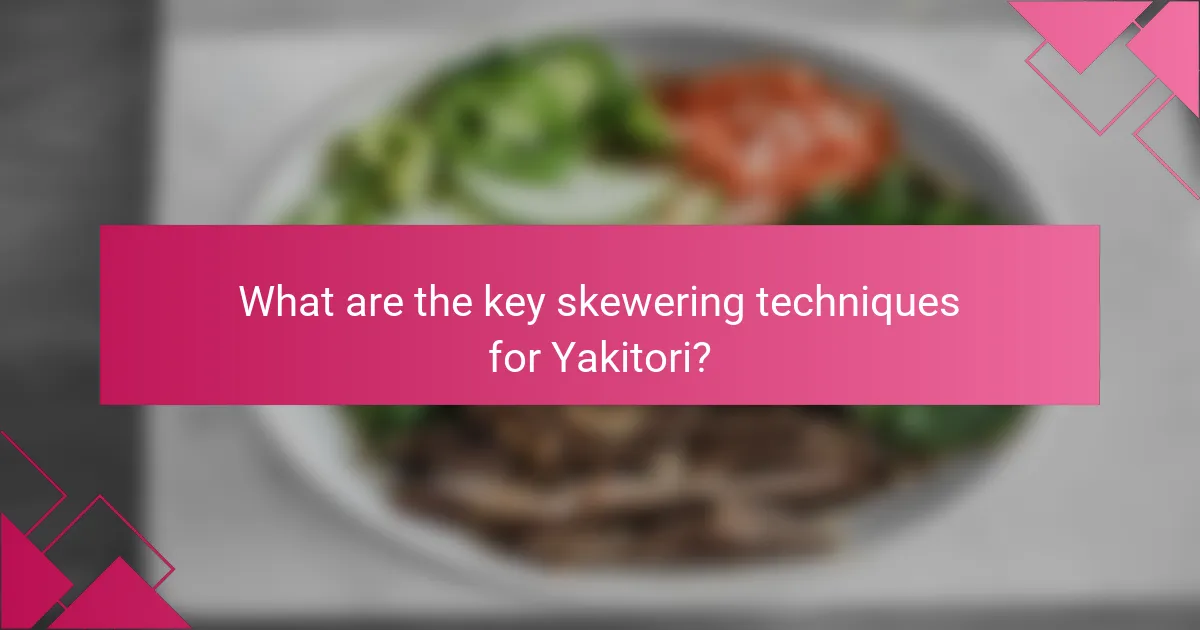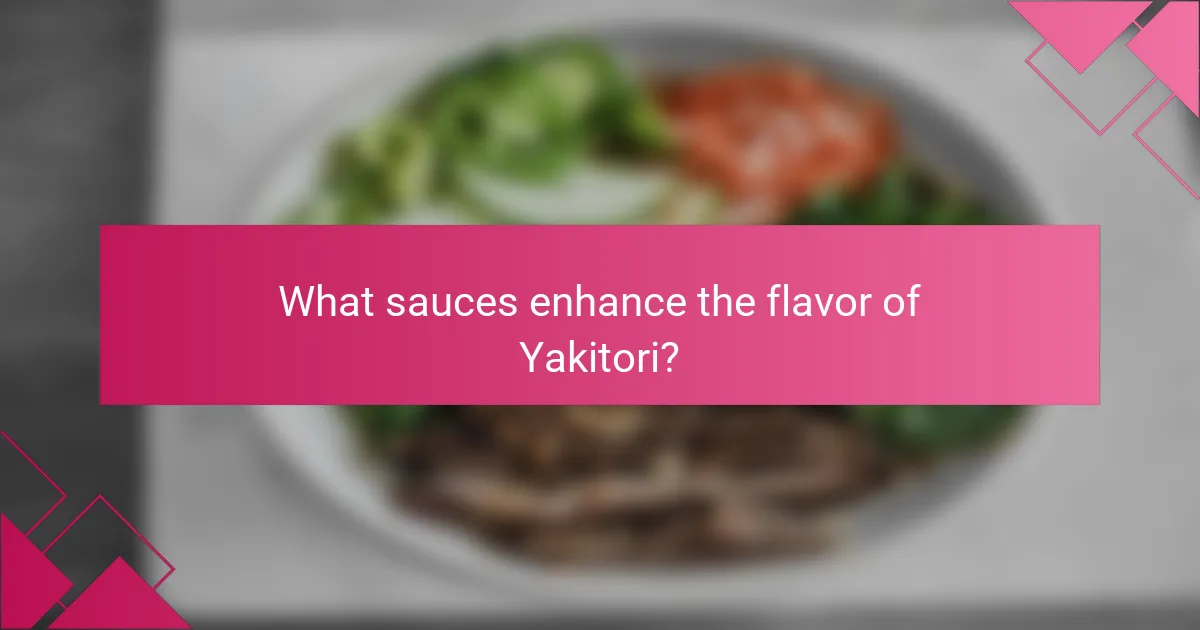
What is Yakitori?
Yakitori is a Japanese dish consisting of skewered and grilled chicken. It typically features various parts of the chicken, including breast, thigh, and liver. Yakitori is seasoned with either salt or a tare sauce, which is a mixture of soy sauce, sake, and mirin. The dish is often served on small wooden skewers, making it easy to eat as a street food or in izakayas. The cooking method involves grilling over charcoal, imparting a distinct smoky flavor. Yakitori has a long history in Japan, dating back to the Edo period. It remains popular for its simplicity and versatility, allowing for a range of flavors and ingredients.
How is Yakitori traditionally prepared?
Yakitori is traditionally prepared by skewering bite-sized pieces of chicken on bamboo sticks. The chicken is often seasoned with salt or brushed with a tare sauce made from soy sauce, mirin, and sake. Cooking occurs over a charcoal grill, which imparts a distinct smoky flavor. The grilling process usually involves turning the skewers frequently for even cooking. Additionally, various parts of the chicken can be used, including thighs, breasts, and even organs. This method highlights the versatility of yakitori, allowing for different flavors and textures. The preparation technique has roots in Japanese street food culture, emphasizing simplicity and quality ingredients.
What types of ingredients are commonly used in Yakitori?
Yakitori commonly uses chicken, particularly various parts such as thighs, wings, and liver. These ingredients are skewered and grilled over charcoal. Other meats like pork and beef can also be used. Vegetables, such as green onions and bell peppers, are frequently included. Additionally, tofu is sometimes incorporated for variety. The choice of ingredients can vary regionally in Japan. This variety contributes to the unique flavors and textures of Yakitori dishes.
What are the different cuts of chicken used in Yakitori?
The different cuts of chicken used in Yakitori include several specific parts. Common cuts are thigh, breast, skin, liver, and heart. Thigh meat is tender and flavorful, making it a popular choice. Breast meat is leaner and has a milder taste. Chicken skin is grilled until crispy and adds texture. Liver offers a rich flavor, while heart provides a unique chewy texture. Each cut contributes distinct flavors and textures to the dish. These cuts are traditionally skewered and grilled over charcoal for optimal taste.
What are the cultural origins of Yakitori?
Yakitori originates from Japan, specifically from the Edo period. It began as a street food in Tokyo. Grilled chicken skewers became popular among laborers. The dish evolved over time to include various parts of the chicken. Traditional yakitori is seasoned with salt or a tare sauce. Tare sauce typically consists of soy sauce, mirin, and sake. Yakitori restaurants, known as yakitori-ya, emerged in the 20th century. Today, yakitori is a staple in Japanese cuisine and culture.
How has Yakitori evolved over time?
Yakitori has evolved significantly since its origins in Japan. Initially, it was primarily made from chicken parts that were grilled over charcoal. The technique of skewering became popular during the Edo period, around the 17th century. At that time, yakitori was often sold by street vendors. Over the years, various chicken parts became standard, including thighs, breasts, and liver.
The introduction of tare sauce, a sweet soy-based glaze, occurred in the early 20th century. This added a new flavor dimension to the dish. Today, yakitori also incorporates a variety of meats and vegetables. Modern restaurants offer diverse styles and innovative flavor combinations. The global popularity of yakitori has led to its adaptation in different culinary traditions.
Overall, yakitori has transformed from a simple street food into a sophisticated dining experience.
What role does Yakitori play in Japanese cuisine?
Yakitori is a significant dish in Japanese cuisine, representing a popular form of grilled chicken skewers. It embodies the essence of izakaya culture, where it is commonly enjoyed with drinks. Yakitori showcases various chicken parts, including breast, thigh, and liver, each offering unique flavors and textures. The preparation often involves seasoning with salt or a tare sauce, enhancing its taste. Traditionally, yakitori is cooked over charcoal, imparting a distinct smoky aroma. It is served in casual dining settings, making it accessible to all. Yakitori also reflects regional variations, showcasing local ingredients and cooking styles. Overall, yakitori plays a vital role in Japanese culinary tradition and social dining experiences.

What are the key skewering techniques for Yakitori?
The key skewering techniques for Yakitori include using bamboo skewers and proper ingredient placement. Bamboo skewers are preferred due to their ability to withstand high heat. Ingredients should be cut into uniform sizes for even cooking. Skewers should be inserted through the meat or vegetables in a way that prevents them from spinning. This technique ensures stability while grilling. Additionally, alternating between different ingredients enhances flavor and presentation. For example, pairing chicken with green onions is common. Proper spacing between pieces allows for better heat circulation. These techniques contribute to achieving the ideal texture and flavor in Yakitori dishes.
How do you properly skewer meat for Yakitori?
To properly skewer meat for Yakitori, use bamboo skewers that are soaked in water. This prevents them from burning during grilling. Cut the meat into uniform pieces, usually about one to two inches in size. Thread the meat onto the skewer, leaving a small space between each piece for even cooking. For added flavor, alternate the meat with vegetables like scallions or bell peppers. Ensure the skewer is not overloaded to maintain proper heat circulation. Skewering in a straight line helps in even cooking. This method is essential for achieving the ideal texture and flavor in Yakitori.
What tools are essential for skewering Yakitori?
Essential tools for skewering Yakitori include bamboo skewers, a sharp knife, and a cutting board. Bamboo skewers are traditional and readily available. They are lightweight and heat-resistant, making them ideal for grilling. A sharp knife is necessary for cutting meat and vegetables into uniform pieces. Uniformity ensures even cooking and enhances presentation. A cutting board provides a safe surface for preparation. These tools facilitate the efficient and safe preparation of Yakitori.
What tips can improve your skewering technique?
To improve your skewering technique, use sharp skewers for easier piercing. Sharp skewers minimize resistance when inserting into ingredients. Choose the right skewer length based on the size of your ingredients. This ensures even cooking and prevents overcrowding. Soak wooden skewers in water for 30 minutes to prevent burning. This step is crucial for grilling over open flames. Arrange ingredients tightly but not too packed for even heat distribution. This allows for proper cooking and flavor absorption. Rotate skewers regularly while grilling for uniform cooking. This technique helps achieve a consistent texture and flavor.
What are common mistakes to avoid when skewering Yakitori?
Common mistakes to avoid when skewering Yakitori include not using the right type of skewers. Bamboo skewers are preferred for their heat resistance and flavor absorption. Another mistake is overcrowding the skewers. This prevents even cooking and proper heat distribution. Additionally, not marinating the meat adequately can lead to bland flavor. It’s important to allow sufficient time for the marinade to penetrate the meat. Using too high of a heat can also be problematic. It may cause the outside to char while leaving the inside undercooked. Lastly, neglecting to soak bamboo skewers beforehand can result in burning during grilling. Proper preparation ensures better flavor and texture in the final dish.
How can improper skewering affect the cooking process?
Improper skewering can lead to uneven cooking of the food. When ingredients are not securely fastened, they may rotate or fall off during grilling. This can prevent the heat from evenly penetrating the food. As a result, some parts may be undercooked while others are overcooked. Additionally, improper skewering can hinder proper heat distribution. This can cause flare-ups if fat drips onto the heat source. Consequently, the overall texture and flavor of the dish may be negatively affected. Uniform cooking is essential for achieving the desired taste and safety in food preparation.
What are the best practices for ensuring even cooking?
To ensure even cooking, use uniform-sized pieces of meat and vegetables on skewers. This practice allows for consistent cooking times. Preheat the grill or pan to the appropriate temperature before adding skewers. Maintaining a steady heat prevents uneven cooking. Turn skewers regularly during cooking to promote even heat distribution. Avoid overcrowding the grill, as this can trap moisture and lead to steaming rather than grilling. For thicker cuts, consider using indirect heat to allow for thorough cooking without burning the exterior. Using a meat thermometer can help ensure that the internal temperature reaches safe levels. Following these practices leads to perfectly cooked yakitori every time.

What sauces enhance the flavor of Yakitori?
Teriyaki sauce enhances the flavor of Yakitori. This sauce combines soy sauce, sake, mirin, and sugar. It provides a sweet and savory glaze. Another popular option is tare sauce. Tare is a mixture of soy sauce, sake, mirin, and sugar. It adds depth and richness to the dish. Salt is a simple yet effective enhancer. It brings out the natural flavors of the grilled chicken. Additionally, shichimi togarashi can be used as a seasoning. This spice blend adds heat and complexity. Each sauce contributes uniquely to the overall taste experience of Yakitori.
What are the main types of Yakitori sauces?
The main types of Yakitori sauces are tare and shio. Tare is a sweet and savory sauce made from soy sauce, mirin, and sugar. It is often used as a marinade or glaze for grilled chicken skewers. Shio, on the other hand, is a simple salt-based seasoning. It enhances the natural flavor of the chicken without overpowering it. Both sauces are essential in traditional Yakitori preparation, providing distinct flavor profiles.
How is tare sauce made for Yakitori?
Tare sauce for Yakitori is made by combining soy sauce, mirin, and sugar. The mixture is simmered until it thickens slightly. Typically, the ratio is two parts soy sauce to one part mirin and sugar. This creates a sweet and savory flavor profile. Some recipes may add sake for depth. The sauce can be brushed onto the skewers during grilling. It enhances the flavor of the grilled chicken. Tare sauce is a staple in Japanese cuisine, particularly for Yakitori.
What is the significance of shio seasoning in Yakitori?
Shio seasoning is significant in Yakitori as it enhances the natural flavors of the grilled chicken. Unlike tare, which is a sweet soy sauce-based glaze, shio allows the taste of the meat to shine through. This seasoning typically consists of salt and may include additional ingredients like citrus zest or herbs for added depth. The simplicity of shio seasoning provides a clean and savory profile, making it a preferred choice for purists. It also promotes a crispy exterior on the chicken, which contrasts well with the tender meat inside. The use of shio in Yakitori reflects traditional Japanese cooking principles that emphasize ingredient quality and balance.
How can you customize Yakitori sauces for personal taste?
You can customize Yakitori sauces by adjusting ingredients to suit your taste. Start with a base of soy sauce and mirin. Alter the sweetness by adding sugar or honey. Increase umami flavor with miso or dashi. Experiment with additional spices like garlic or ginger for depth. Incorporate citrus zest for brightness. Adjust the thickness by varying the cooking time. Taste the sauce during preparation to ensure it meets your preferences. Personalizing Yakitori sauces enhances the overall dining experience.
What ingredients can be added to create unique flavors?
Various ingredients can be added to create unique flavors in yakitori. Common additions include marinades such as soy sauce, mirin, and sake. These ingredients enhance umami and sweetness. Herbs like shiso or basil introduce fresh, aromatic notes. Spices such as togarashi or black pepper provide heat and complexity. Citrus zest, like yuzu or lemon, adds brightness. Sesame seeds contribute nuttiness and texture. Additionally, miso paste can deepen flavors with its savory profile. Each ingredient alters the overall taste experience, making yakitori versatile and appealing.
How do different cooking methods affect sauce application?
Different cooking methods significantly influence sauce application on yakitori. Grilling allows sauces to caramelize, enhancing flavor and texture. This method creates a sticky glaze that adheres well to the skewers. Steaming, on the other hand, prevents sauce thickening, resulting in milder flavors. Boiling can dilute sauces, leading to a less concentrated taste. Each method alters the moisture content, affecting how sauces cling to the meat. For instance, high heat from grilling intensifies the sauce’s flavor profile. In contrast, simmering can infuse the sauce into the meat but may wash away surface flavors.

What flavor enhancements can elevate Yakitori?
Marinades and sauces can significantly elevate Yakitori. Teriyaki sauce adds a sweet and savory glaze. Soy sauce enhances umami flavor. Miso paste offers depth and richness. Citrus juices, like yuzu or lemon, provide brightness. Spices, such as shichimi togarashi, introduce heat and complexity. Fresh herbs like shiso add aromatic freshness. These enhancements create layers of flavor that complement the grilled meat.
How do marinades impact the flavor of Yakitori?
Marinades significantly enhance the flavor of Yakitori. They infuse the chicken with various tastes, depending on the ingredients used. Common marinade components include soy sauce, sake, mirin, and sugar. Each ingredient contributes unique flavors, such as umami from soy sauce and sweetness from mirin. The marinating process allows the chicken to absorb these flavors over time. This results in a more complex and flavorful dish. Additionally, marinades can tenderize the meat, improving its texture. Studies show that marinated meats exhibit enhanced flavor profiles compared to unseasoned counterparts.
What are some effective marinade recipes for Yakitori?
Soy sauce, mirin, and sake create a classic Yakitori marinade. Combine equal parts soy sauce and mirin. Add a splash of sake for depth. This mixture enhances the umami flavor of the chicken. Another effective marinade includes soy sauce, honey, and garlic. The honey adds sweetness while the garlic provides aroma. A third option is a spicy marinade with gochujang, soy sauce, and sesame oil. This blend gives a unique heat and richness to the dish. Each marinade can be adjusted to taste, allowing for customization. Marinate the chicken for at least 30 minutes for optimal flavor absorption.
How long should you marinate Yakitori for optimal flavor?
Marinate Yakitori for optimal flavor for at least 30 minutes to 2 hours. This duration allows the marinade to penetrate the meat effectively. For enhanced flavor, marinating overnight is also beneficial. The longer marination time deepens the taste and tenderness of the chicken. Using a soy sauce-based marinade can enhance umami flavors. Research shows that marinating meats can improve juiciness and flavor absorption.
What garnishes can complement Yakitori dishes?
Green onions, also known as scallions, are a common garnish for Yakitori dishes. They add a fresh, mild flavor that enhances the overall taste. Shredded daikon radish provides a crunchy texture and a peppery taste that complements grilled meats. Sesame seeds can also be sprinkled on top for a nutty flavor and visual appeal. Additionally, shiso leaves offer a unique herbal note and vibrant color to the dish. Finally, a drizzle of tare sauce can enhance the umami profile of Yakitori. These garnishes collectively elevate the dining experience by adding flavor, texture, and presentation to Yakitori.
How do fresh herbs and vegetables enhance Yakitori presentation?
Fresh herbs and vegetables enhance Yakitori presentation by adding color, texture, and aroma. The vibrant greens of herbs like cilantro or shiso create visual contrast against the grilled meats. Vegetables such as bell peppers or zucchini provide additional layers of color and can be arranged artistically on the skewer. This visual appeal can elevate the dining experience, making the dish more appetizing. Aromatic herbs also contribute to the overall fragrance, enhancing the sensory experience of the meal. Studies show that food presentation significantly influences perceived taste and enjoyment. Therefore, incorporating fresh herbs and vegetables not only beautifies Yakitori but also enhances its overall appeal.
What are traditional garnishes used in Yakitori serving?
Traditional garnishes used in Yakitori serving include sliced green onions, shichimi togarashi, and lemon wedges. Sliced green onions add freshness and a mild onion flavor. Shichimi togarashi is a spice blend that enhances the dish’s flavor. Lemon wedges provide acidity, balancing the savory taste of grilled chicken. These garnishes are commonly used in Japanese cuisine to complement the main dish. They enhance both presentation and taste, making the meal more enjoyable.
What are the best practices for grilling Yakitori at home?
The best practices for grilling Yakitori at home include using high-quality ingredients, proper skewering techniques, and maintaining the right temperature. Start with fresh chicken, preferably thighs, as they provide better flavor and moisture. Cut the meat into uniform pieces for even cooking. Soak bamboo skewers in water for at least 30 minutes to prevent burning. Preheat the grill to medium-high heat for optimal cooking. Use a two-zone setup for grilling, allowing for direct and indirect heat. Brush the skewers with tare sauce or salt during grilling to enhance flavor. Turn the skewers frequently to achieve even browning. Ensure the chicken reaches an internal temperature of 165°F for safe consumption. These practices help create authentic and delicious Yakitori at home.
Yakitori is a traditional Japanese dish made of skewered and grilled chicken, showcasing various parts of the bird, such as thighs, breasts, and liver. This article covers essential aspects of yakitori, including traditional preparation methods, key ingredients, and the cultural significance of the dish. It also delves into the various skewering techniques, sauces like tare and shio, and tips for enhancing flavors through marinades and garnishes. Additionally, best practices for grilling yakitori at home are outlined, ensuring an authentic dining experience.
